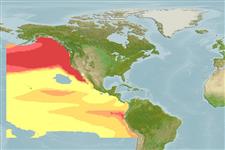>
Myctophiformes (Lanternfishes) >
Myctophidae (Lanternfishes) > Diaphinae
Etymology: Diaphus: Greek, dis, dia = through + Greek, physa, phyo = to beget, to have as offspring (Ref. 45335); theta: Named after the Greek letter and refers to the body photophores which are divided horizontally by a fine line of black pigment (Ref. 6885).
More on authors: Eigenmann & Eigenmann.
Environment: milieu / climate zone / depth range / distribution range
Ökologie
seewasser bathypelagisch; tiefenbereich 10 - 3400 m (Ref. 50550), usually 10 - 400 m (Ref. 28981). Deep-water; 66°N - 20°S
Eastern Pacific: common in California Current region to 20°S (Ref. 31442), including Hawaii (Ref. 4925). Northwest Pacific: throughout subarctic-transitional waters to northern Japan (Ref. 31442).
Length at first maturity / Size / Gewicht / Alter
Maturity: Lm ?, range 6 - ? cm
Max length : 11.4 cm TL Männchen/unbestimmt; (Ref. 4925)
Kurzbeschreibung
Bestimmungsschlüssel | Morphologie | Morphometrie
Rückenflossenstacheln (insgesamt) : 0; Rückenflossenweichstrahlen (insgesamt) : 12 - 14; Afterflossenstacheln: 0; Afterflossenweichstrahlen: 12 - 14; Wirbelzahl: 34 - 36. Adipose small, narrow based, slender (Ref. 6885). Brown to black on dorsal surface, lighter ventrally; fins pale (Ref. 6885). Branchiostegal rays: 9 (Ref. 31442).
Epipelagic to mesopelagic (Ref. 31442). Feed at night or in the morning (Ref. 9199), on euphausiids, copepods, and amphipods (Ref. 11712). Oviparous, with planktonic eggs and larvae (Ref. 31442). Lipid content is 15.8 % in fresh body weight while wax ester is present in trace amounts (Ref. 9197). Minimum depth reported from Ref. 28981.
Clemens, W.A. and G.V. Wilby, 1961. Fishes of the Pacific coast of Canada. 2nd ed. Fish. Res. Bd. Canada Bull. (68):443 p. (Ref. 4925)
IUCN Rote Liste Status (Ref. 130435)
Bedrohung für Menschen
Harmless
Nutzung durch Menschen
Tools
Zusatzinformationen
Download XML
Internet Quellen
Estimates based on models
Preferred temperature (Ref.
123201): 4.8 - 15.3, mean 7.9 °C (based on 504 cells).
Phylogenetic diversity index (Ref.
82804): PD
50 = 0.5000 [Uniqueness, from 0.5 = low to 2.0 = high].
Bayesian length-weight: a=0.01000 (0.00436 - 0.02294), b=3.04 (2.86 - 3.22), in cm total length, based on LWR estimates for this Genus-body shape (Ref.
93245).
Trophic level (Ref.
69278): 3.2 ±0.1 se; based on diet studies.
Generation time: 2.2 ( na - na) years. Estimated as median ln(3)/K based on 1
growth studies.
Widerstandsfähigkeit (Ref.
120179): hoch, Verdopplung der Population dauert weniger als 15 Monate. (Preliminary K or Fecundity.).
Fishing Vulnerability (Ref.
59153): Low to moderate vulnerability (25 of 100).
